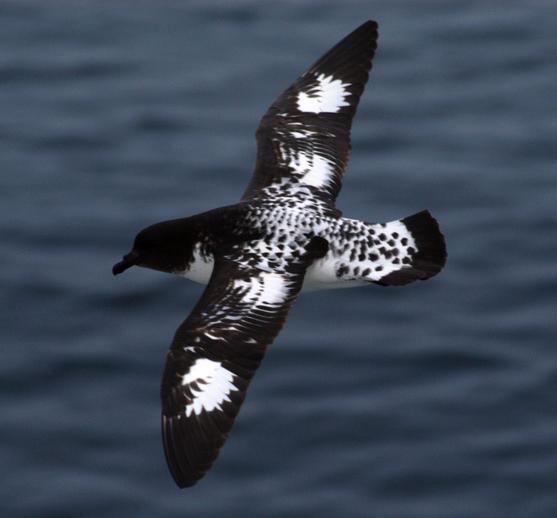Cape Petrel (Daption capense) - Wiki Cape Petrel
From Wikipedia, the free encyclopedia
Order: Procellariiformes
Family: Procellariidae
[Photo] Cape Petrel (Daption capense) flying over the Drake Passage. Author: Author Gonzalo V??squez (www.flickr.com/photos/gvasquez/). Date: November 25, 2005. Source: Flickr (http://flickr.com/photos/gvasquez/71149259/in/set-1532993/)
The Cape Petrel, Daption capense, is a common seabird of the Southern Ocean from the family Procellariidae. It is the only member of the genus Daption, and is allied to the fulmarine petrels. It is also sometimes known as the Cape Fulmar, Cape Pigeon, or Pintado Petrel The Cape Petrel has two subspecies, Daption capense capense and Daption capense australe.
The Cape Petrel is a distinctive-looking medium-sized procellariid with an entirely black head and neck. The belly and breast is white; the underwing is white with a black border. Its back and upperwings are speckled black and white, and the tail is white with black speckles and a terminal band of black. This plumage pattern is unique amongst the procellarids.
Cape Petrels breed on numerous islands surrounding Antarctica. A few pairs nest as far north as New Zealand's Auckland Islands, the Chatham Islands and Campbell Island; the majority of the species nest further south. The species' stronghold is on the Antarctic Peninsula and the islands of the Scotia Sea. They also breed on other sites on the Antarctic mainland, as well as South Georgia, the Balleny Islands, and Kerguelen Island. They are colonial, nesting on rocky cliffs or on level rocky ground no further than a kilometre from the sea. The nests are simple and are usually placed under an overhanging rock for protection. A single egg is laid in mid to late November and incubated for around 45 days. Both parents take shifts of several days incubating the egg, with the male shifts on average lasting a day longer. Like fulmars Cape Petrels will aggressively defend their nesting site by ejecting stomach oil at intruders; skuas in particular will prey on Cape Petrel eggs and chicks. Once hatched the chick is brooded for 10 days until it is able to thermoregulate, after which both parents hunt at sea to feed it. Cape Petrel chicks fledge after around 45 days.
Cape Petrels feed predominantly on crustaceans at sea, which compose around four-fifths of their diet; they will also take fish and squid. Euphausiid shrimp are their main prey, taken both by surface seizing, plunging under the water and filtering the water. Their habit of pecking at the water to seize prey is the origin of one of their common names, the Cape Pigeon. They also regularly attend fishing vessels and carcases at sea. Cape Petrels are extremely aggressive at sea both towards their own species and others, and will even spit oil at competitors. They are also habitual ship-followers. During the summer Cape Petrels feed close to Antarctica's shelf; during the winter they range much further, reaching Angola, Australia and even the Galapagos Islands.
Cape Petrels are extremely common seabirds; their population is estimated to be around 2 million birds. They are not considered threatened.
http://en.wikipedia.org/wiki/Cape_Petrel
| The text in this page is based on the copyrighted Wikipedia article shown in above URL. It is used under the GNU Free Documentation License. You may redistribute it, verbatim or modified, providing that you comply with the terms of the GFDL. |
